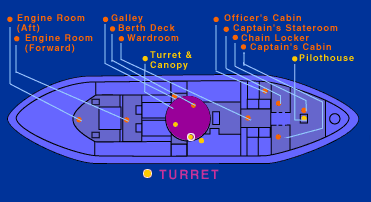
|

|

|

|
|
Intro
|
Galley
|
Deck
|
Canopy
|
Wardroom
|
Officer's Cabin
|
Captain's Cabin
|
Captain's Stateroom
|
Turret
|
Pilothouse
|
Chain Locker
|
Berth Deck
|
Engine Room - Forward
|
Engine Room - Aft Turret Although the concept of a revolving gun turret was not novel to armed forces of the mid-19th century, the USS Monitor was the first vessel in history to incorporate this engineering feature. The revolving gun turret allowed the ship's crew to aim cannons without having to position the ship to deliver a broadside. The Monitor's gun turret consisted of an iron skeleton covered with eight layers of one-inch-thick plates. Only 20 feet in diameter on the inside, the turret was a claustrophobic place in combat. Inside were two 11-inch Dahlgren smoothbore cannons, which were mounted on specially designed "friction carriages" and operated around and under the skeletal frame. On recoil, the cannons cleared the diagonal braces with only about two inches to spare. After workers assembled the turret, they drilled three 20-inch-diameter holes through the armor, one atop the other, to make each gun port. Thick iron pendulums (or port stoppers) that hung from the overhead protected the gun-port openings. Crew swung the port stoppers out of the way when they ran the cannon out for firing and dropped them back into place on recoil to protect themselves from enemy fire. The Monitor's cannons were muzzle loaders, meaning that powder and shot were loaded into the cannon from the business end. Because of the confined space inside, each port stopper had a hole through its center to allow the handles of the gun tools to pass through. During loading, the handles protruded outside the turret; when not in use, the loading implements hung from the overhead. Crew members stored a limited number of non-exploding solid shot along the base of the turret beside each of the guns. As the turret slowly revolved, crew would pass powder and exploding shells up from below. The turret floor had four hatches (two beside each gun) for access down to the berth deck. The turret was controlled by linkage at the rear of the starboard gun. Below deck, two donkey engines (small auxiliary engines) connected to a crank—which, in turn, was connected to four gears—put the turret in motion. Its maximum speed was two revolutions per minute. Before the turret could be revolved, it had to be "keyed up." On the forward side of the midships bulkhead was a Y-shaped structure called the turret support truss. This large mount helped displace the weight of the turret resting on the deck above. In the center of the truss stood the turret shaft, which crew raised into position by pulling a large wedge underneath. As they tightened a large nut on the end of the wedge, the shaft slowly rose up to connect with the yoke on the main beam at the bottom of the turret. Once the shaft was in place, crew members turned the control wheel in the turret, which increased the steam pressure to the donkey engines and put the turret in motion. Tour the Monitor | Behind the Scenes Eyewitness to the Battle | Steam Machine | Resources Transcript | Site Map | Lincoln's Secret Weapon Home Previous Sites | Adventures | Join Us/E-mail | TV/Web Schedule Teachers | Site Map | Search | Shop | To print PBS Online | NOVA Online | WGBH © | Updated October 2000 |
||